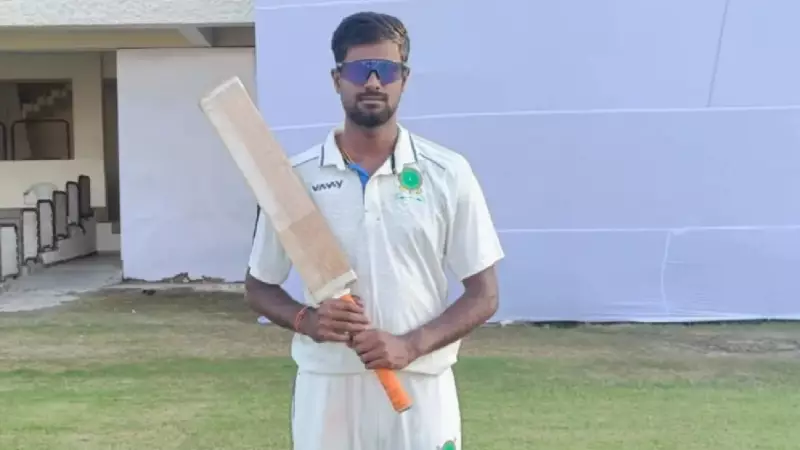
Historic Feat Sparks Ranji Trophy Format Debate
The Ranji Trophy, India's premier domestic cricket competition, finds itself at the center of a heated debate following an extraordinary batting performance that has divided cricket purists and administrators alike. The record-shattering display came from Meghalaya's Akash Kumar Choudhary, who achieved what no cricketer in the 250-year history of first-class cricket had accomplished before.
Unprecedented Records Tumble in Surat
During Meghalaya's Ranji Trophy encounter against Arunachal Pradesh at the C K Pithawala Ground in Surat, Akash Kumar Choudhary scripted history with a breathtaking display of power hitting. The 25-year-old batsman smashed eight consecutive sixes off the bowling of Arunachal's Limar Dabi and T N R Mohit, breaking multiple world records in the process.
Akash's remarkable achievement didn't stop at the eight sixes. He also registered the fastest-ever fifty in first-class cricket history, reaching the milestone in just 11 deliveries. His triple century came in slightly over three hours, contributing to Meghalaya's massive innings lead of 1,008 runs and eventual victory margin of 725 runs.
This performance pulled down legendary names from the record books, including Garry Sobers, Mike Procter, and Ravi Shastri, who previously held the record for six consecutive sixes in first-class cricket.
Systemic Issues Behind Record-Breaking Feats
The historic achievement has brought attention to the structural changes in Indian domestic cricket following the Lodha Committee reforms implemented in the 2018-19 season. The expansion of the Ranji Trophy pool to include teams from Northeast states with limited cricketing tradition has created what many former players describe as a diluted competition.
Former BCCI General Manager of Cricket Operations, Saba Karim, expressed concern about the current structure. "With so many teams (38) in contention in the Ranji Trophy, the quality of the structure is diluted. It may not be a bad idea to have these Plate division games in Tier 2... they can attain First Class status once they are promoted to the Elite division," Karim told The Indian Express.
The statistics support these concerns. Arunachal Pradesh, against whom Akash achieved his record, has managed only one victory in 40 matches while suffering 35 outright losses. Similarly, Meghalaya, one of the nine teams introduced post-Lodha reforms, is yet to register a significant victory against established teams.
Pattern of Extraordinary Performances
Akash's record-breaking performance is not an isolated incident in the expanded Ranji Trophy format. The 2022-23 season witnessed Mumbai defeating Uttarakhand by a staggering 725 runs - the highest victory margin in first-class cricket history worldwide.
In the same season, Jharkhand set a never-before-seen target of 1009 runs against Nagaland in a pre-quarterfinal fixture. More recently, Hyderabad's Tanmay Agarwal broke multiple first-class records in a single day against Arunachal Pradesh, including the fastest triple century (147 balls) and most sixes (26) in an innings.
These extraordinary performances have become increasingly common since the integration of Northeast teams into the first-class system, raising questions about the competitive balance.
Administrative Challenges and Solutions
The BCCI faces significant challenges in restructuring the domestic calendar. Saurashtra stalwart Sheldon Jackson, a two-time Ranji Trophy winner, highlighted the logistical complexities. "It is not easy to host 38 teams across several age-group systems and the senior level. You will have to then reconstruct the entire structure because otherwise you would not be able to relegate teams like, say, Hyderabad, from the top," Jackson explained.
Jackson also defended the emerging teams, pointing out that Nagaland recently came close to denying traditional powerhouse Tamil Nadu full points. "These teams have just come up in the last decade, and they are competing. You cannot come and dominate teams that may have a legacy of nearly 100 years. Some teams are evolving," he added.
The current promotion-relegation system sees two bottom-ranked teams relegated from the Elite division each season, with Plate finalists replacing them. This constant churn has contributed to the mismatch in competitive standards.
Recognition and Future Direction
Despite the debates surrounding the quality of opposition, Akash Kumar Choudhary's achievement has received official recognition from the International Cricket Council (ICC) and the Association of Cricket Statisticians and Historians as a legitimate first-class record.
Karim suggested a potential way forward: "Unless the BCCI's working committee at the AGM figures out something like having two tiers of Ranji Trophy, I think it is very difficult. There have been encouraging signs in white-ball cricket from the Northeast, but in red-ball cricket, we can think of having a distinction."
As Indian domestic cricket continues to evolve, the balance between inclusion and maintaining competitive standards remains a pressing concern for administrators, with Akash's historic feat serving as the latest catalyst for this important conversation.





